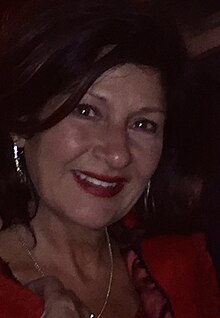

Elena Aprile
| |
|---|---|
 | |
| Born | (1954-03-12) March 12, 1954 (age 70)
Milan, Italy
|
| Alma mater | University of Naples University of Geneva |
| Known for | XENON Dark Matter Search |
| Scientific career | |
| Fields | Physics |
| Institutions | Columbia University |
| Doctoral students | Reshmi Mukherjee |
Elena Aprile (born March 12, 1954) is an Italian-American experimental particle physicist. She has been a professor of physics at Columbia University since 1986. She is the founder and spokesperson of the XENON Dark Matter Experiment. Aprile is well known for her work with noble liquid detectors and for her contributions to particle astrophysics in the search for dark matter.[1][2]
Aprile studied physics at the University of Naples and completed her masters thesis at CERN under the supervision of Professor Carlo Rubbia.[3] After receiving her Laurea degree in 1978, she enrolled at the University of Geneva, from which she received her Ph.D. in physics in 1982. She moved to Harvard University in 1983 as a postdoctoral researcher in Carlo Rubbia's group. Aprile joined the faculty of Columbia University in 1986,[3] attaining her full professorship in 2001. From 2003 to 2009, Aprile served as co-director of the Columbia Astrophysics Laboratory.
Aprile is a specialist in noble liquid detectors and their application in particle physics and astrophysics.[4] She began working on liquid argon detectors as a graduate student at CERN, continuing her research as a postdoctoral fellow at Harvard. At Columbia she investigated the properties of noble liquids for radiation spectroscopy and imaging in astrophysics.[5] This work led to the realization of the first liquid xenon time projection chamber (LXeTPC) as a Compton telescope for MeV gamma rays.
From 1996 to 2001, Aprile was spokesperson of the NASA-sponsored Liquid Xenon Gamma-Ray Imaging Telescope (LXeGRIT) project, leading the first engineering test of the telescope in a near-space environment and subsequent science campaigns with long-duration balloon flights. LXeGRIT used a liquid xenon time projection chamber as a Compton telescope for imaging cosmic sources in the 0.15 to 10 MeV energy band. A total of about 36 hours of data were gathered from two long-duration flights in 1999 and 2000, at an average altitude of 39 km.[6][7][8]
Since 2001, Aprile's research focus shifted to particle astrophysics, specifically to direct detection of dark matter with liquid xenon.[9] Aprile is the founder and spokesperson of the XENON dark matter experiment, which aims to discover WIMPs as they scatter off xenon atoms in massive yet ultra-low background[10] liquid xenon detectors operated deep underground.[11]
| International |
|
|---|---|
| National |
|